Blog
Sumbiography
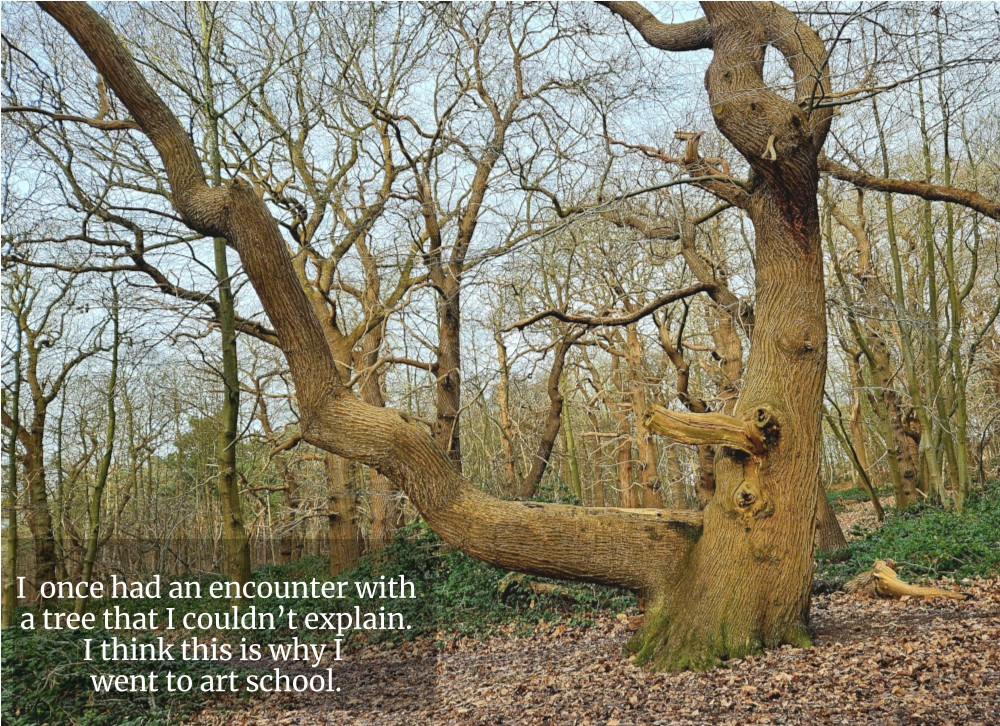
I once had an encounter with a tree that I couldn’t explain.
I think this is why I went to art school.
The term “sumbiography” was coined by Australian environmentalist Glenn Albrecht to refer to the collection of life experiences, from childhood to adulthood, that shape a person’s perspective on the relationship between humans, other living beings, and nature. [1] I was introduced to the term by Bridget McKenzie (of Climate Museum UK, and Culture Declares Emergency) as part of her excellent Earth Talk series. She suggested that as a brief introductory exercise, participants in the group—who have gathered to learn from her work about responding to Earth crisis—could reflect on what their own sumbiography would include.
As someone who always struggles to provide a sensible professional bio, Bridget’s prompt to write a sumbiography has been a very pleasurable exercise, reminding me of the seemingly miraculous encounters and lively connections that influence my outlook, and drive my work. Every evening for a week I retrieved and reflected on one experience from my childhood memory.
In doing so, I discovered that encounters with different life-forms and landscapes were deeply embedded in family life. Creatures played (or were made to play) many roles in my childhood—friends, enchanters, musicians, pets, tormentors, workers, family members, quarry, cultural trophies, muses, food sources, inspirations, and mysterious beings.
One (remembered) photo stands out: I am twelve years old, holding a snail on a leaf. I look happy, curious, proud, and also maybe a little shy—presenting it as if it were a fascinating new best friend.
The Catlows weren’t really pet people. Dad still pats the heads of dogs nervously with a stiff hand. My Great Aunt Jean found cats deeply unsettling, or in her words, “itchycoo”. She loathed them weaving and purring in a figure of eight around her ankles. Of course, cats adored her.
In Cumbria, where I spent weeks of the Summer at my Grandparents’ place with my brother – My uncle William had Springer Spaniels. They were not pets but working dogs, sent to fetch pheasants shot from the sky for sport. My grandmother Connie, would complain when they returned from a hunt and ran, all wet and floppy with mud, around the house. But she would still brew them a pot of tea and pour it, with a splash of milk, into their bowls, bestowing them the status of hardworking family members.
Aunt Lizzie loved birds, she had shelves full of books containing delicate and expressive drawings of them. Lizzie would complain bitterly about the pheasants hanging lifeless in the kitchen. Uncle William would meet her dismayed cries of disapproval — half objection, half horror — with disdainful sneers, casting them as sentimental, feeble, and irrelevant. In my memory, these repeated disagreements take place, out of time, against a background of curlews’ mournful calls curving upwards in low overlapping whistles through the drizzle in the mists across the sands at Grange.
Food was another arena where these tensions played out. Connie strongly disapproved of my vegetarianism. She had no hesitation in letting me know that she regarded it as a Southern affectation, and a perverse betrayal of my Catholicism and my God-given dominion, as a human, over all creatures of the Earth.
Only now, can I guess at Connie’s secret despair when I rejected meat over factory farming. What on earth would she feed me? After all, a meat dish with a good strong gravy, was her language of love: steak and kidney pie, Lancashire hot pot, shepherd’s pie, a roasted chicken, or joint of pork, or lamb. Then we could look forward to the cold cuts in the next day’s picnic featuring great chunks of meat in floury white baps, with slabs of butter, and mayonnaise, or mustard, or mint. On Carmell Fell, or out on one of the high mountains of the Lake District I would sit with Matt and my cousin Jane on some huge granite rock, munching happily.
Great Aunt Jean was a good person — steady, morally upright, a primary school head mistress devoted to the well-being of others. Her garden in Waddington, Lancashire, stretched long and narrow, with a winding path that led through an arch of pink climbing roses down to a tiny brook. The soft fluting calls of the wood pigeons filled the air, as if in a story. Even now, every wood pigeon song I hear evokes those remembered feelings of faith, grace, and safety that I felt in my Auntie Jean’s garden.
Amid these family dynamics I once had an encounter with a tree that I couldn’t explain. I would need to dedicate myself to exploring it further. I think this is why I became an artist.
On a visit to Porthleven as an art student, newly arrived in Cornwall from London, I watched the black crows hurling themselves into spiralling jets of wind at Loe Bar. The sea roared and pounded the steep pebble shore like a relentless and wild war drum. Beyond the Bar, the surface of the freshwater lagoon was a still black mirror. This scene still embodies for me life’s great mystery—the simultaneous existence, and contrast between worldly tumult and the infinite potential of inner stillness.
Since 2019, against the backdrop of mass species extinctions, we at Furtherfield have been working with creatures as mentors, using participatory role-play experiences to explore interspecies justice and governance. It’s serious play that sensitises me to the mysterious and inexplicable things that happen around us all the time.
Last year I went for a swim in my home town. Gorgeous hot day. Sparkling sea. Big swell. I found myself paying attention to the seagulls. Like you do in meditation – observing their movements, the way they fly together and across each other. Listening to their wheezy cries. Then one swooped down and dropped a £20 note on a wave right in front of me!
[1] Albrecht also coined the terms “sostalgia” for the emotional distress suffered as a result of negatively perceived environmental change, and “symbioscene” a proposed future era where humans live, emotionally, psychologically and technologically in harmony with the natural world.
Asking for help as a new world |The Hologram feminist, peer-to-peer health
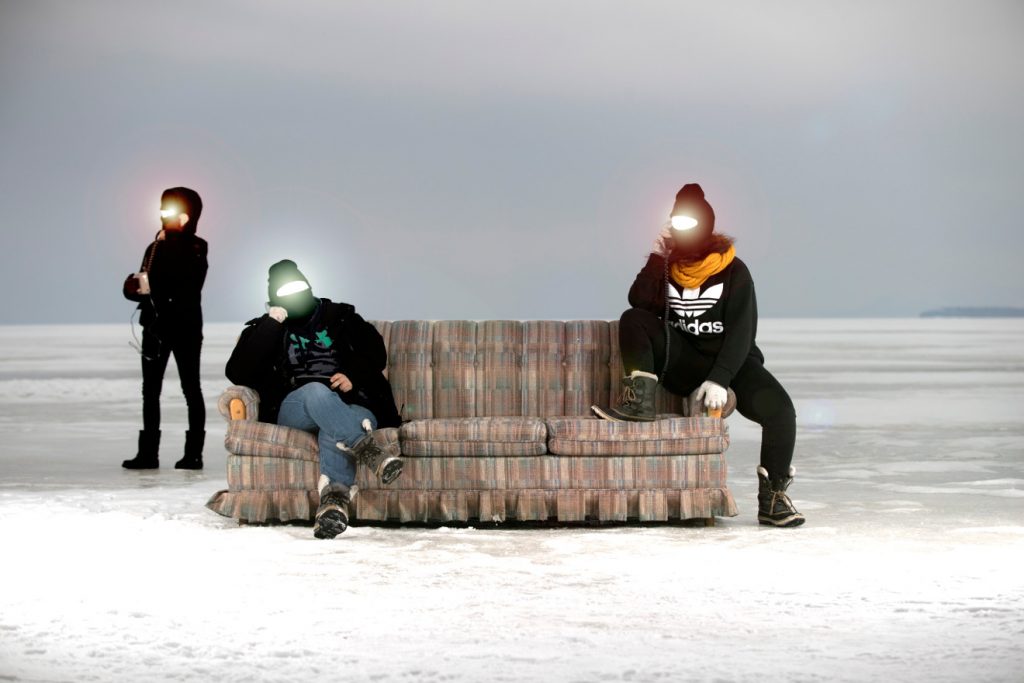
This week I join the second gathering of the CreaTures project (Creative Practices for Transformational Futures).
We are ecstatic at Furtherfield to be artistic partners in this 3-year programme as it puts us in collaboration with fantastic artists and researchers from around the world who focus on the role of creative practices in moving the world towards socio-ecological sustainability. Our role is to produce two large scale artworks as the subject of enquiry about how to support social practices that seek to be transformative. They are The Hologram by Cassie Thornton and The Treaty by Cade Diehm and myself (in collaboration with a load of other people).
If you want to learn more about the CreaTures partners, people and projects involved check out this link. On Tuesday, I will have the pleasure of talking to the CreaTures team about the second Hologram Course and thought that some of you might find it interesting too.
If you prefer to learn straight from the horse’s mouth, buy the Hologram book. I find it an enjoyable read full of inspiration and insights into ways to resist the kinds of network cultures (and the ideas about what constitutes politics and care) that are fed to us by and about social media platforms.
A bit of background. Furtherfield hosted Cassie in a residency Feb-May this year. The idea was to provide space and support to develop the format for a concept she had been working on for a couple of years inspired by solidarity clinics and integrative health-care systems in the Greek islands during the 2015 migrant emergency in Greece. The Hologram is an artwork and a peer to peer feminist healthcare system that is openly anti-capitalist. Her residency ended up being wrapped in the pandemic, and so she moved presentations, workshops and the first course that she developed with Lita Wallis, online. This is all in the book.
As part of CreaTures, she is now running the second course called ‘We must begin again: Asking for help as a new world‘. And it is this that I wanted to share some experiences and thoughts about. First, I need to say a bit more about how the Hologram works.
Someone (called the hologram) asks 3 people if they would agree to join them in a regular conversation about their wellbeing. It is a long-term commitment.
These people form a triangle around the hologram. Over time they build a multi-dimensional picture of the hologram’s wellbeing from 3 different perspectives: emotional, physical and social. They do this by becoming curious, listening, and learning how to ask useful questions. Cassie describes these people as the hologram’s medical records. In this way the hologram teaches the people in their triangle how to care for them – they are the experts of their own situation. The triangle helps the hologram to see patterns and find the support they need in many ways, including helping them with research into particular life-crises as they arise.
The community gathering around this project is creating an experimental space that is testing a variety of linguistic and bodywork techniques.
Like an inverse pyramid scheme – the value (knowledge, understanding, healthcare) sits with the person who is the hologram (in a reversal of professionalised healthcare) – there is no expectation of reciprocation. This is not a transaction; it is care. It is important that people in the triangle will also be holograms – so that the knowledge about collective healthcare can be shared. This is not a replacement for state-healthcare. It is, however, more necessary in some parts of the world (USA) than others – and the process so far has revealed just how stark are the interconnected problems of debt, racism, access to healthcare, housing. Also, most vivid – is the emerging crisis of complex trauma amongst professional healthcare workers themselves.
I’ll finish up by saying a few things about this second course:
1. We are working with the CreaTures team to approach the question of transformation in artworks (I’ll let you know how we get on with that).
2. We have a wonderful auto-ethnographic researcher who is taking the course, and keeping a journal of her experience of the course itself. This teaches us all a huge amount about what happens inside one participant.
3. We will be having conversations about the question of “audience” for this work – and I’m not yet sure what I will have to say about this. But there is something about a work that is co-created by its own audience – and any other audience is perhaps irrelevant.
4. This course which is run on Zoom, is built around group exercises on 4 very potent themes: Trust, Wishes, Time, Patterns. You can probably imagine just how potent this is in the context of pandemic futures.
If I can’t Dance…
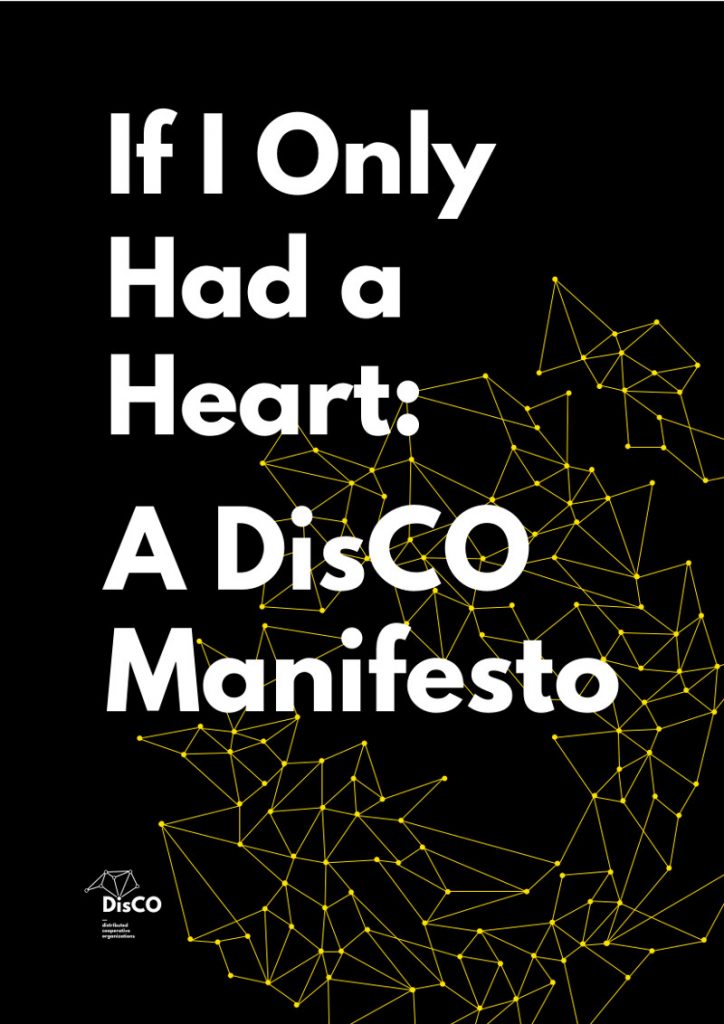
DisCOs exist to midwife a better future for work.
The DisCO manifesto induces a song in the heart and a skip in the step to those who, like me, yearn to see varied collectives of self-organised people empowered through more distributed forms of governance.
Distributed Cooperative Organisations (or DisCOs) are P2P/Commons, cooperative and Feminist Economic alternative to Decentralised Autonomous Organisations (or DAOs) blockchain-based entities that can operate autonomously to execute payments, levy penalties, and enforce terms and contracts with minimal human interaction.
“The DisCO takes a friendly but carefully planned approach to people working together to create value in ways that are cooperative, commons-oriented and rooted in feminist economics. DisCOs are amplified by the power of Distributed Ledger/Blockchain technologies, harnessing the utility of tech without being completely tech-centric, emphasizing mutual trust and remembering to have fun.” They use the best aspects of DAO tech, and to apply them to inclusive, locally grounded and transnationally networked cooperatives that focus on social and environmental work.
Download and read the DisCO Manifesto here, with a foreword written by me.
What does success look like in the arts?
Curator Anabel Roque Rodriquez interviewed me as part of her series on success in the arts with a focus on political art, art as labor, feminism, and the art market.
The interview starts by asking about the role of fame in the arts…
Fame is a currency in the arts. Art workers can trade it to get stuff and others speculate upon it. This probably applies in other sectors that depend on the reputation in an attention economy. The drive for fame in the arts promotes a culture of competitive individualism, the myth of genius, and is a denial of the deep interdependence of a healthy cultural ecosystem. It does however make an excellent topic for critical play. By working with attention, fame, influence and speculation as a medium, artists like Amalia Ulman, Jeremy Bailey and Jonas Lund make visible the contortions that we must all (not just art workers) undergo in social media and crypto platforms – in order to participate and survive in daily life…
Read the full interview here >>
Interviewed for Blockchain. The Trust Catalyst. Neural Issue 60 Summer 2018

Blockchain. The Trust Catalyst. Neural Issue 60 Summer 2018
I have been interviewed with Marc Garrett in a this Summer’s fascinating issue of Neural Blockchain. The Trust Catalyst edited by Rachel O’Dwyer.
Neural: You founded Furtherfield organisation and platform in the second half of 1990s, embracing the first Internet utopia and fostering (digital) collaboration as a fundamental value in art practice. How do you see the relationship between your original undertaking with your current interest for blockchain?
Ruth Catlow and Marc Garrett, Furtherfield: Since 1996 we have explored network technologies to organise, create and take control of art contexts with others. Seeking a less dominated and more hackable artworld (and way of life) [1], we came together with artists, techies and activists, across many disciplines to develop an ethos and set of approaches [2] that we termed DIWO (Do It With Others) [3].This was an update on the DIY spirit of punk, the political interventionism of Situationism, and was inspired by Free and Open Source Software culture, and characterised by remix, appropriation, tactical media antics, and collaborative artistic platform building.
Blockchains have spawned a flurry of production and hype that outstrips even the early days of the web. Their emergence coincides with accelerating global financialisation and the rise of art as a financial asset class, for speculation, hoarding and money laundering. In 2015 Furtherfield launched the Art Data Money programme which set out to explore how blockchains and big data might be used to build a commons for the art in the network age.
This work grew out of conversations with Rob Myers. In his artworks and writing he drew out the historic and political resonances and tensions within and between art and crypto cultures. In 2014 he wrote a provocation called DAOWO- DAO it With Others. This invited us all to think about how DIWO processes might combine with Decentralised Autonomous Organisations to incorporate elements of automated governance into collaborative art production.
You can find the rest of the interview here
We go on to discuss how artists are working with the technologies; the rise of digital collectibles and how blockchains collide with spirit of participative net art “that wants to be free”; other initiatives such as the campaign for the ‘Fair Art Market’ led by DACs in the UK; and impacts on wider global value regimes.
[1] Richard Stallman. Free Software Is Even More Important Now. (no specific date)
[2] Collaboration and Freedom – The World of Free and Open Source Art collection with P2P foundation, Curated by Furtherfield
Is The Future Forked?! On Rob Myers’s cryptocurrency-sci-fi
DOWNLOAD BAD SHIBE BY ROB MYERS HERE with illustrations by Lina Theodorou
Such future. Very crypto. Much catastrophe. Wow.
Bad Shibe is published as the Internet of information (the World Wide Web) is being superseded as the next big thing by the Internet of value and assets (the blockchain). It invites us to imagine what kind of society emerges when a system designed to verify the transfer of digital assets is combined with a world where reputation is based on “followers” and “likes”. It is a tale of loss of innocence, and it is also packed full of good jokes!
Information isn’t what it used to be. Once regarded as an infinite resource and wellspring of universal emancipation, decontextualized information now washes through our societies like toxic waste, glutting electronic superhighways and neuronal byways, and confuzzling global populations. And so, the cryptocurrency evangelist speaks to a present-day yearning for a global system that might provide a trustworthy structure — an economics of information, and an informational economy.
The story deals with the implications of a new wave of fully financialised planetary-scale automation and the struggle to discern right from wrong when human and machine agency merges. It also invites us to think of humans and societies as much as the effects of technology as its beneficiaries.
About the Author
“In a post-truth world, authenticity and accuracy are the twin chambered beating heart of communication” Karla Ptáček, Avatar Body Collision
Rob Myers is an artist, hacker, and writer. For more than two decades his work has probed and clarified the significance to society of practices in expressive and engineering cultures, from the apparently mundane and bureaucratic to the deeply mysterious. Through his artworks, many of which take the form of software, he plays with concepts of art, value, authorship and creation in the age of digital networks. My appreciation of Rob Myers’s oeuvre has developed and intensified over the last decade. And it is no exaggeration to say that his art and writing have made it possible for me to endure the difficulty (and with it sometimes boredom) of learning about the emerging technical protocols of our age that lie beyond the candy coated surfaces of the social web, and the new analytical approaches and techniques for exploring their consequences.
Bad Shibe is typical of his work in many ways. The text is packed with delicious references and jokes that derive from high, low and pop cultures; from art, literature and computer science; from “maximally pre” and since-net. It is simultaneously high art and high geek. Its time-of-writing is encoded in every utterance of its characters, the topics of their conversations, and the structure of their grammar and syntax.
World Shibe Web
“My mouth goes “Ew!” and my face is totally onboard with that.” – YS is disgusted by the Salesbro’s display of antique money.
Bad Shibe is a meditation on the emergence of ideologies propounded and executed by an elite of technical experts who are also free market believers. YS lives in a post-gender, post-fiat (government backed) money era in which tweens work in orchards to pay for school.- YS is a little wrapped up in themselves and gives a running commentary of their every action, in a way reminiscent of MUDs and MOOs – early virtual worlds in which you write your world, relationships, and passage through them into existence. In the tradition of some of the best dystopian literature (by for instance Russell Holborn, Kathy Acker) the mode of language is fundamental to its worlding. The categories of speaking, thinking, intending and acting overlap for YS in ways that conventional language doesn’t allow. This overlapping affects how bodies, beliefs and consciences work in this future anarchic higgledipiggle of dustbowl landscapes, green shield stamps, milk crates, apples, wraps, blue hair, drones, phones and 3D printers, and a city that resembles circuits. A symbolic world as much as a material one.
Concepts of sin, illegality, hazard, faith and social embarrassment are interchangeable for YS – a confusion that plays out in subtle yet profound ways in the story. It is also possible YS is not entirely in control of their phone and is able to affect the world in ways they have not yet understood. The narrative is powered by a surge of jealousy which causes YS to doubt the integrity of the reputation market that is their whole world, and to feel bad.
Bad conscience: the 3000+ year old innovation of city dwelling priesthoods that enabled the masses to internalise the techniques of their own oppression now mediated through the Panopticon conceived by enlightenment utilitarianism guru Jeremy Bentham, and the Netopticon via which corporations and states are able to track and monitor our every action online. The Netopticon 2.0 dramatised in Bad Shibe institutes the 360 degree all-dimensional, all-perspectival review, analysis, critique and management of the algorithmic citizen by the algorithmic citizen. As a result, the entanglement of emotional, legal and financial relations is complete. In the near now of Bad Shibe, morality is reduced to what is provable (YS tells us “the market doesn’t care about motivation”), in the service of the market, on the blockchain, and therefore it is forever.
Some readers might like some background on cryptocurrencies and the blockchain, with which the speculations of Bad Shibe concern themselves.
What do we need to know about cryptocurrencies and blockchains?
“Pups love AreWeThereYet, but it’s just a game. It’s the underlying currency protocol and the analytics overtop that matter..” – UnoY
A cryptocurrency is digital, but it can be used and exchanged like other currencies. The “crypto” bit refers to the techniques used to prevent counterfeiting and maintain its security. Bitcoin, the leading example of cryptocurrency was launched by the pseudonymous Satoshi Nakamoto in 2008, just as, and in part perhaps because (there is evidence to suggest) the banks were being bailed out by government with taxpayers’ money. Cryptocurrencies are not issued by a central authority like a country, nor controlled by a central bank. Instead, their value and use as an exchange medium is reached by consensus between its users using blockchain technology. In cyptocurrency, trust in the mathematics of cryptography and the fairness of market forces replaces trust in people and institutions.
The value of a cryptocurrency is set by market supply and demand, just as with gold or silver. Hard metals derive their value from scarcity and the difficulty of extraction, with cryptocurrencies the only difficulty is computational, the only scarcity by design. Miners’ machines run software that uses processing power and lots of energy to compete for coins. To mine new coins, these computers periodically gather up a “block” of new transactions from across the network and then race to solve a difficult mathematical puzzle for that block. The winner is said to have successfully mined the block, granting them ownership of the freshly minted coins and any transaction fees paid by users.
This new block incorporates a reference to the previously mined block (represented by its “cryptographic hash” ID number), and joins a sequential, unmovable chain of blocks. The security and stability of a blockchain is maintained because all users hold a record of every transaction made. Because each new block takes so much computational power to mine, it very quickly becomes prohibitively expensive to hack the currency.
The blockchain solves the longstanding computer science problem of the (delightfully named) Byzantine Generals: “How do I prove that the payment I have received can be honoured, in order that I may release my asset to the payee?”
The initial advertised benefits of cryptocurrencies (there are lots of altcoins now all with slightly different features) included the lack of interference by states and banks, the “trusted third parties” Nakamoto’s white paper, required in all solutions to the Byzantine Generals problem; the low cost of payment processing (compared with wire transfers); and the ability of its underpinning blockchain technology to provide infrastructure connecting transactional apparatus to secure votes and shares holdings. Because of the anonymity of transfers, Bitcoin is also said to have facilitated money laundering, the trading of illicit goods and nefarious services such as assassination markets.
What do we need to know about Dogecoin?
Dogecoin is a real world altcoin, from which the near-future society of Bad Shibe seems to have evolved. It’s not hard to see why Myers would chose this lovable altcoin at the basis for his story.
Dogecoin launched in December 2013 as a joke cryptocurrency based on a dog meme. The central design of the crypto-token is the enchanting face of the shiba inu puppy which exudes trusting, playful positivity. It says “WOW” and is encircled by the words “very currency wow much coin how money so crypto plz mine v rich” in the delightful meme based language of Doge, so satisfying for joking. And as Brett Scott writes:
The Doge is a figure without ego, with cross-cultural, cross-gender, and yes, even cross-species appeal. We can all get something from the gaze of the Shibu. This is reflected in the resultant community that has emerged around Dogecoin, people who refer to themselves as ‘shibes’ and give each other gifts of Doge. While the Bitcoin subreddit has turned into a moshpit of aggressive trolling, Dogecoin forums feel inclusive and accepting, cohering around a surreal world of esoteric slogans and acts of goodwill.
The Dogecoin currency is “dug” at high frequency, for low financial value. Users both express and inspire generosity, through extravagant tipping, showing their appreciation, or admiration of others. This proved to be a remarkably successful community building strategy. In 2014 (at the time that Myers was writing Bad Shibe) the fiat-value of the currency blew up unexpectedly, and by January it had achieved a market capitalisation of $60million. Shibes adopted the phrase “going to the moon!”, which originated with Bitcoin, using it ironically to describe the coin’s rising value (making everyone holding it rich)
Two years is a long time in Doge years
Rob Myers wrote Bad Shibe in 2014. Since 2013 blockchain-based platforms like Ethereum have been under development to enable software programmes known as “smart contracts” to perform actions and administer capital across digital networks without human user verification. The result is Decentralized Autonomous Organisations, and Applications (DAOs and DAPPs), that act like computer viruses with wallets in their pockets. They have ambiguous legal status, and therefore operate outside of government regulation. While this is one of the main attractions to people whose political complexion we might describe as anarcho-capitalist and who ask “what has regulation ever done for us?”, there is growing concern about the impact of these technologies. As Dr Catherine Mulligan puts it “The redefinition of society will happen in smart contracts and these kind of places unless the law courts are actively ensuring that people aren’t getting disenfranchised” and the worry is that society is being restructured by a small unrepresentative group of technocrats while “it’s something that everyone needs to participate in – the discussion about society and economy and also governance, how we rule ourselves.”
Bad Shibe explores a number of threats to a society operating on the logic and infrastructure of cryptocurrency systems, smart contracts and DAOs and anticipates “The DAO hack” of 2016. The software fork that followed was highly controversial and split the community in a moment reminiscent of the theological schisms of medieval Christianity. Breaking with one of the core tenets of blockchain ideology, that all actions on the blockchain are immutable and sit forever and into eternity outwith potentially corrupting human influence, it prompted a true crisis of faith in the blockchain community. It is also the subject of one of the best jokes in Bad Shibe (look out for the Claes Oldenberg reference).
Some final thoughts
Bad Shibe is fiction based in fact.
It helps us to feel our way around some of the consequences of the global infrastructure under construction. This is conceived by one blockchain start-up, BackFeed as “a social operating system that enables massive open-source collaboration without central organisation” for a world free from the tiresome daily deliberations, discussions and negotiations of both ethics and politics. One in which we could avoid all conflict (from the horrors of war to blushes of social embarrassment) simply by hard-wiring social softwares for justice and good manners. In this universe the only limits we face are to our powers of imagination, innovation, organisation and coordination. We could do away with the need for trust, by creating and maintaining a shared open record of all actions and transactions, and mechanising all incentives and punishments, from now to eternity. A universal, decentralised and frictionless infrastructure to facilitate the productive forces of free markets – to satisfy every desire of every shibe?
Ruth Catlow February 2017
Exhibiting Networking the Unseen at Furtherfield
Last Friday we opened an exhibition curated by Gretta Louw, and featuring Yama, an installation she has made in collaboration with Neil Jupurrurla Cook, the Artistic Director of the Warnayaka Art Centre, along with other artists and members of the Warlpiri people of Lajamanu, in Central Australia.
Networking the Unseen is the first exhibition of its kind to focus on the intersection of indigenous cultures and zeitgeist digital practices in contemporary art. While digital networks manifest physically as tonnes of cabling, and electrical or electronic devices, the social and cultural impacts of the networks remain somehow invisible, eroding clearly felt boundaries of geography, place, culture and language.
With the Warnayaka Art Centre, over 4 or 5 years Gretta has formed an extraordinary artistic bridge. The Yama installation is delicious, respectful, bold and provocative, in the face of social, political and environmental stress, and an exchange fraught with potential ethical and etiquett-ical bear-traps.
The exhibition also features work by 5 other Australian artists of diverse heritages: Lily Hibberd, Brook Andrew, Curtis Taylor, Jenny Fraser, Sharon Nampijinpa Anderson.
On Saturday Gretta led a tour of the exhibition. Then Warlpiri educator Steve Jampijimpa Patrick talked about the work in the context of the five pillars of Warlpiri culture. You can watch the short video that he showed here.
The discussion of “so called technology” pursued questions of: cultural continuity, churn and loss; in contrast with stories said to pre-date humans; medium-message relations (McLuhan-stylee); the opportunities and threats of openness and sharing in amongst the global flows of capital in the network age.
I noticed as Jampijimpa drew in the sand, how his drawing resonated with the network diagrams that have informed and shaped our work at Furtherfield for the last 20 years, our understanding of the importance of connectedness and especially our DIWO campaign.
I cannot properly convey the full impact that these meetings and events are having on me and the other people who have attended. It is unfolding slowly, in unexpected ways. Yama, is a Warlpiri word translates as ‘reflection’- sky to land, inward to outward, shadow falling from object across another object. I will write more with more reflections as they arise and as I talk to others.
I urge you to see the exhibition if you can, which is open every weekend until August 14th.
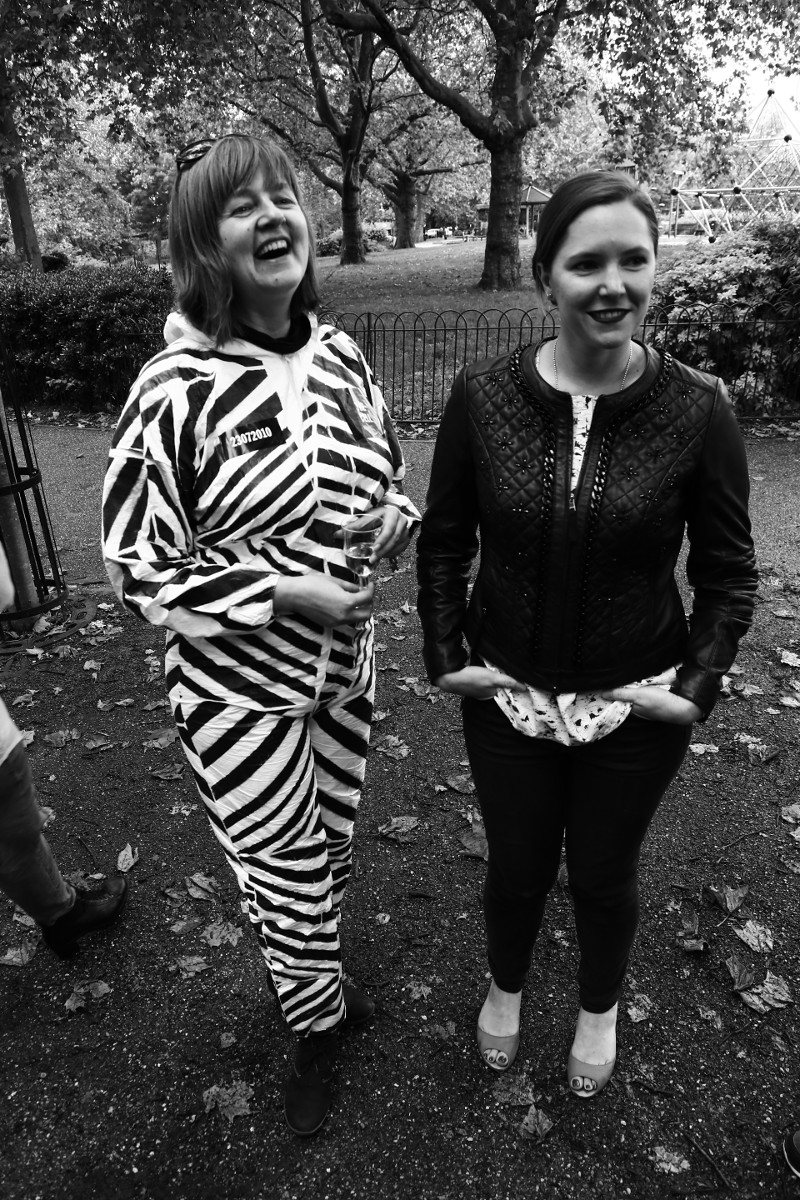
Me with Gretta Louw. I am wearing a costume from Brook Andrew’s ‘The Cell’. Photo is by Michael Erglis
My name is […] and I am an Accelerationist
![My name is […] and I am an Accelerationist My name is […] and I am an Accelerationist](https://ruthcatlow.net/wp-content/uploads/2016/04/slurpee.jpg)
April-May 2017 we hosted an online debate at Furtherfield called We Need to Talk about Accelerationism “Back in 2013 Alex Williams…
Blog: Art and the Blockchain
I recently participated in the Blockchain Beyond Fintech event at the Digital Catapult in London.
I was invited to give a “firestarter” talk in the middle of the day, to introduce a different perspective on the potentials for the blockchain.
I also wrote a blog for the event about how artists are using blockchain technologies and why it is important.
“As the underpinning technology for Bitcoin, the blockchain is widely heralded as the new internet. Alex Puig, CEO of the Digital Currency Summit, calls it the “Internet of Value”.
The blockchain is a decentralised infrastructure for automating, monitoring and verifying transactions, and this promises to facilitate the monetisation and marketisation of all things networked. It is no surprise then that the sponsor of the most recent Ethereum London Meetup was speaking to the room when he said, “We can make finance great again!”
While the technical protocol is now well described, conversations about blockchain’s transformative potential beyond FinTech are yet to attract the same level of debate and development within other sectors – let alone connect with a wider public. This is a problem because technologies develop to reflect the interests of those who develop them. Artists can help here.”
Read more
Time Is Speeding Up
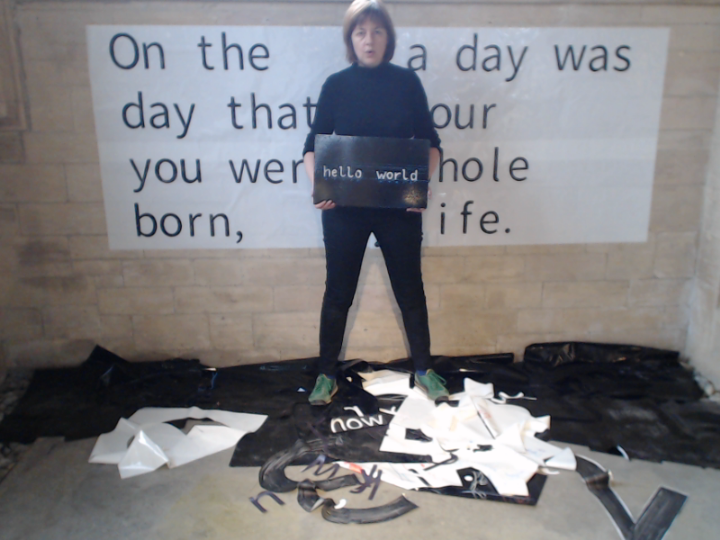
I’m just back from Scunthorpe, where I have been installing/performing a new networked video piece at 20-21 Visual Arts Centre…
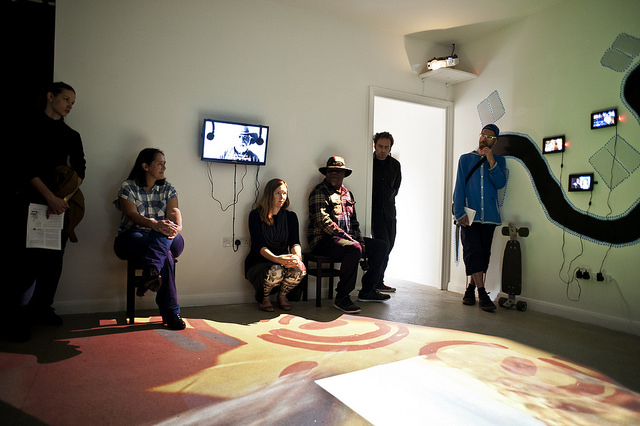
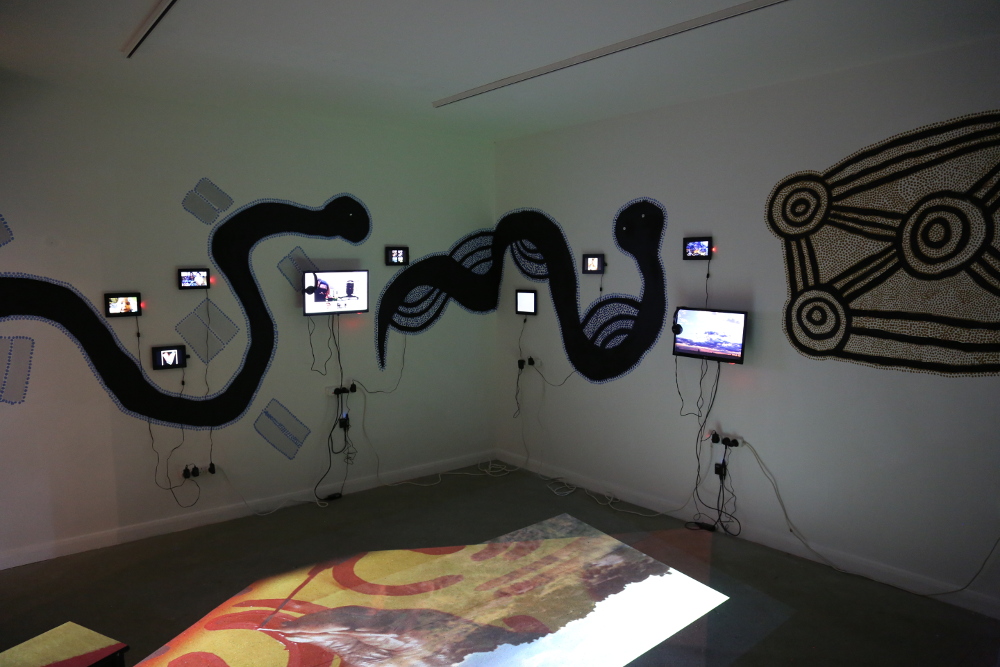
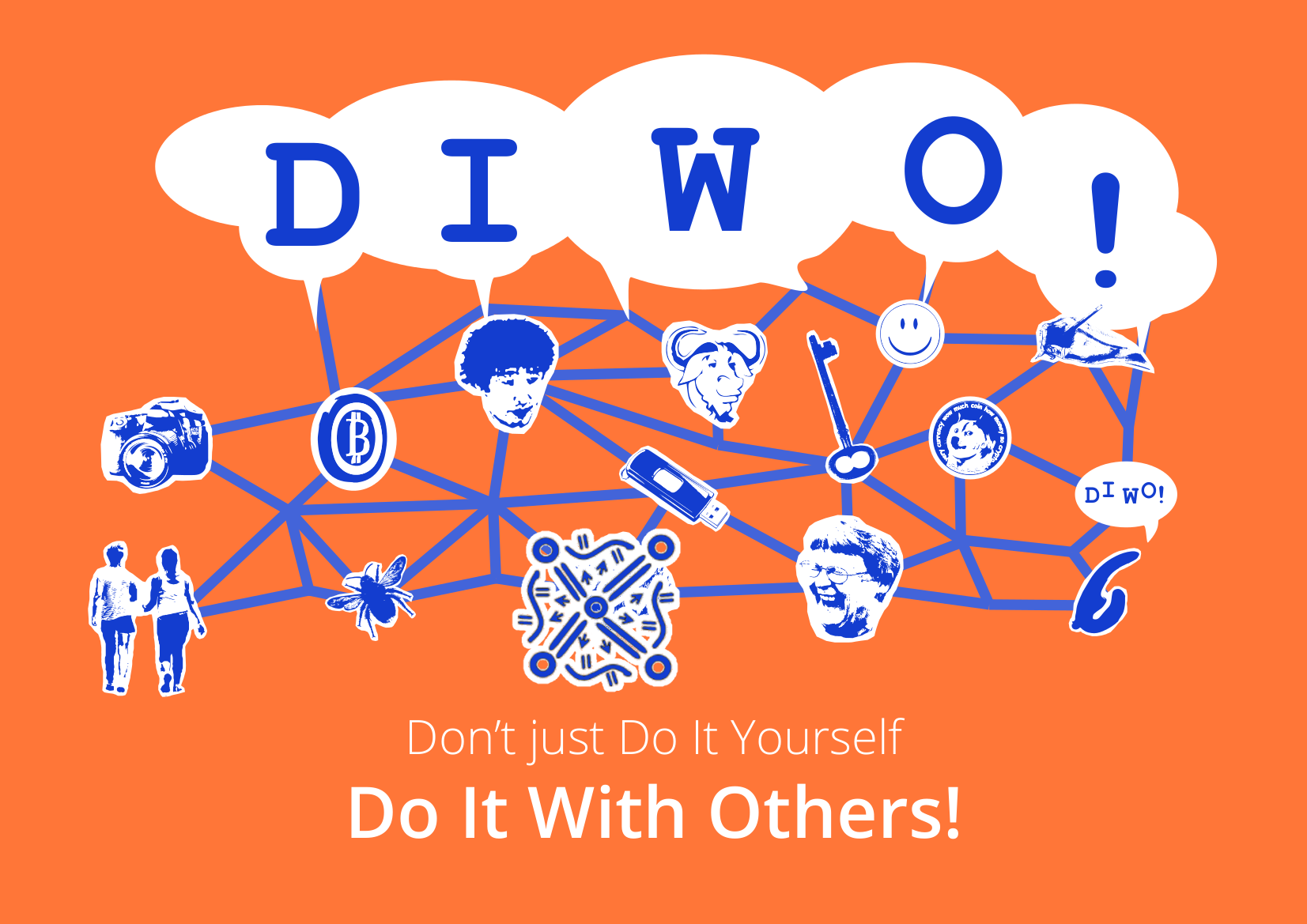
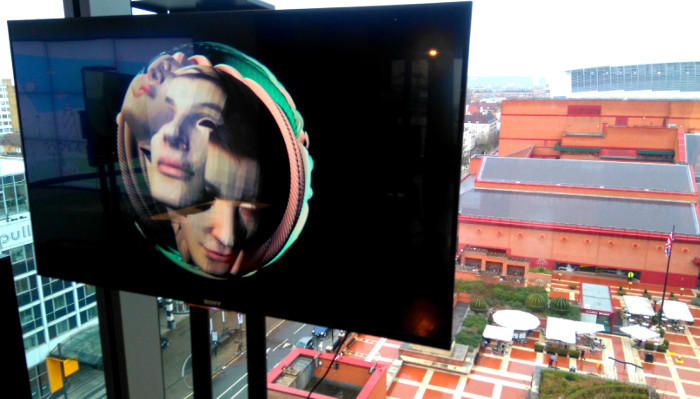

Recent Comments